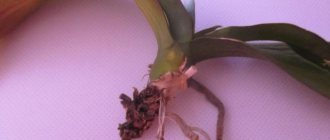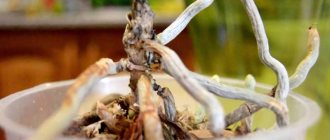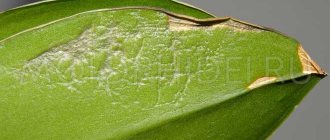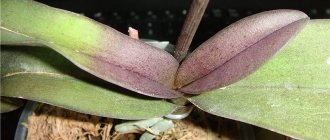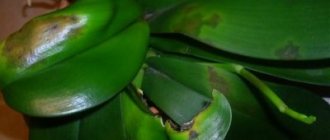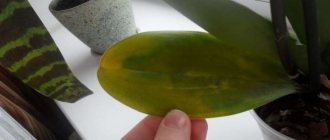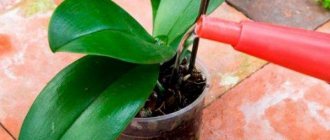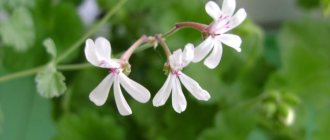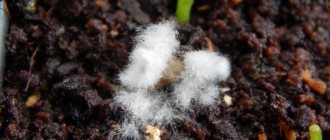An orchid is a flower that can decorate and enliven any interior. The plant does not need any special care, but it is still recommended to follow basic rules.
Failure to maintain the balance of watering or temperature conditions can lead to white mold appearing on the orchid. Quite often, white mold on the soil of indoor plants not only spoils the appearance, but also leads to their death.
When white mold appears on house flowers, the spores can spread to neighboring pots of plants both through the air and through contact of leaves. If white mold appears on the stem of a phalaenopsis orchid, take immediate measures to remove it before the spores affect the entire collection. You may find the article “Mold on Seedlings” useful.
Appearance
Mold is a coating formed by mold fungi on the surface of plants. The so-called “seeds” of mushrooms (spores in scientific terms) move freely around the room and can easily infect not only flowers, but also various surfaces.
Color varies from light gray to greenish. Mold looks like a furry crust on the surface of the flower .
Reference! Often, mold can appear on the roots of an orchid, but the roots, stem and leaves of the flower itself are susceptible to this disease.
Mold
On orchids
The familiar mold becomes a frequent enemy of orchid lovers. It can be seen on rotting fruits, damp walls, and, even worse, on your favorite plant. It consists of many types of fungi that can spread extremely quickly using microscopic spores.
Mold spreads very quickly.
Most common types
- White mold . In appearance it looks like fluffy lumps of medical cotton wool;
- Blue mold . Settles in islands, fluffy.
This fungal disease can affect all plant organs and even the substrate. So you can find mold on flowers, leaves, stems and bark.
Reasons for appearance
Mold appears on orchids just like on any other object. The fluffy coating spreads over everything that is accessible to it. Spores necessary for reproduction may be present in the substrate or in the air. The most optimal conditions for this are humidity and warmth.
Mold is easy to see with the naked eye. A clear sign that will help distinguish one species from another is color.
Most often, troubles with plants occur as a result of improper care . It is known that mold requires moisture and heat to spread. Such conditions are fundamental for the development of almost everything:
Mold itself does not harm the plant. She is a saprophyte, which means that she feeds on decaying organic matter, that is, she will not touch a healthy plant. In this case, she can warn that rotting and other diseases that will be much more difficult to treat are so close.
How to get rid of it?
Let us consider in more detail what to do in this situation, how to combat the formation of this disease on various parts of the flower.
On the leaves
There are two types - white and black.
If white mold appears on the surface and in the axils of the leaves, this is the initial stage of the disease. You can fight it with a solution of copper sulfate. To do this, take a teaspoon of vitriol and dilute it in 2 liters of water. The solution should be a pale blue color . They should wipe the leaves, especially carefully in places where mold accumulates the most. Or spray 2 times a day until the plaque disappears.
If black mold has already appeared on the flower, then it is better to carefully trim the affected leaves and wipe the cut areas with the same vitriol solution.
On the roots
This type of fungus is more difficult to fight.
- First of all, it is necessary to completely dry the substrate in which the orchid grows.
- Then it is recommended to thoroughly loosen the soil, remove the flower itself from the pot and thoroughly rinse the damaged areas (recommended water temperature 35 degrees); if dried roots are found, it is better to carefully trim them.
- Place the treated flower (stems and roots) in the fungicide solution for 15 minutes.
Important! The fungicide solution should be concentrated to 1/6 of the concentration stated in the instructions. Otherwise, you may get a chemical burn to the flower.
In the substrate
Moldy soil is best disposed of . Before planting the orchid in a new substrate, you need to soak it (soil) in boiling water for about 15 minutes. After this, wait until it dries completely and only then fill the container where you place the orchid.
It is recommended to put 3 crushed tablets of activated carbon or wood bark into the substrate. After planting, it is not recommended to water the orchid for about 3-5 days. This is done to ensure that the damaged areas heal and new problem areas do not form. It is also advisable to place the orchid in a well-lit, dry place.
Below you can watch a video that tells you what to do with mold on an orchid:
If the entire plant is affected
If the flower is completely covered with mold, then you can try to carefully cut off the mold with a sharp knife , then treat the damaged areas with a solution of copper sulfate (how to prepare it is indicated above).
It is also recommended to transplant the flower into another pot with a new substrate, previously disinfected. After this, do not water the flower for 5 days and keep it in conditions with minimal air humidity, preferably in direct sunlight. Even in this case, you can use ultraviolet lamps and warm the orchid with them.
Advice! The main thing is not to overdo it, so as not to get a thermal burn of the flower. If these measures do not help, then the flower must be disposed of; nothing can help it, no matter how sad it may sound.
Why does a plant become moldy?
White mold appears on flowers as a result of overwatering combined with high room temperatures. The most dangerous time of year is hot summer, when you want to save your favorite flowers from the heat by introducing additional watering. We do not recommend spraying the orchid, as moisture on the leaves leads to the development of fungus.
But mold can also appear if you buy a flower already infected with spores. Fungal colonies are dormant in the substrate, on leaves, flowers, and stems.
How to fight white mold on the leaves of indoor plants? Flower shops offer a variety of remedies for mold deposits on soil and indoor flowers. In this case, the products are divided depending on the type of fungal infection (white or black mold) and are selected for different plants, for example, flowering plants, palm trees, cacti, and so on.
How not to treat a flower?
- Under no circumstances should high humidity be allowed in the room where the flower is located.
- Don't overdo the chemicals used to combat mold.
- Although drying and a sunny place for treating the flower are recommended, one should not forget that prolonged exposure to direct sunlight (especially in the hot summer period) can lead to thermal burn of a delicate orchid.
- If you use a solution of copper sulfate or fungicide, then you should not allow a high concentration of these chemicals, as this can cause a chemical burn to the flower.
What is the danger of the phenomenon?
Algae are not parasites, so they do not pose a danger to the orchid. But, in some cases, they cover the bottom with a dense layer and accumulate on the inner walls of the pot, making it difficult for air circulation in the soil and the breathing of roots.
Important! The appearance of moss or green algae indicates violations in the care and maintenance of the orchid.
Such a plant needs urgent adjustment of its care regimen .
Prevention
To do this, you need to make drainage holes in the pot where the flower grows. The substrate in which the orchid is located must be dried occasionally, that is, do not water it for several days. It is best to use clean filtered water for irrigation.
Occasionally add a weak solution of potassium permanganate to the water for irrigation (the color should be soft pink, not brighter). Sometimes you can add a couple of tablets of activated carbon or tree bark to the orchid substrate. Maintain temperature conditions. The optimal temperature is 22-25 degrees. Avoid high humidity and it is best to place the flower in a sunny place.
Disinfect the pot
If you plan to use an old pot, thoroughly clean the inside and outside of it to remove any small particles of soil and dust. To do this you will need a stiff brush and soap solution.
After the dirt has been removed, be sure to disinfect the container with a solution of potassium permanganate, diluting 1 g of potassium permanganate in 5 liters of water. This will help get rid of fungal pathogens and avoid re-infection of the flower.
If the pot is new, just rinse it with soapy water.
Post-treatment care
An orchid that has suffered a fungal disease is best placed for a while away from other plants. It is advisable that it be a dry, warm, well-ventilated room. Provide the flower with access to the sun. Also, after treatment and removal of mold, it is best not to water the flower for several days; it is necessary to periodically loosen the soil in which the orchid grows.
The renewed substrate can be treated with a solution of foundationazole (two grams per liter of water). Twice a month it is recommended to dilute 0.5 teaspoon of citric acid in a glass of water and water the plant with this solution. Some gardeners recommend dropping a few cloves of garlic into the orchid pot after watering. You need to keep them there until the soil dries completely after watering and then remove them.
You can also use dried citrus peels . Place them around the flower for a couple of days.
Orchids are also susceptible to other diseases. Read about yellowing, wilting, drying, rotting, plaque, cracking of leaves, falling of flowers and leaves, baying.
So, we have figured out why the roots and other parts of the orchid become moldy and what to do about it. The most important thing is not to panic when you notice signs of this disease, but to provide timely assistance to the flower. Regularly inspect the flower for symptoms of mold and follow simple rules for caring for the plant. Periodically carry out preventative maintenance on your orchid and then it will delight you with its color for a long time.
Rinse the roots
First, fill the orchid with a small amount of water. After 10-15 minutes, the substrate will soften and you can easily remove the plant from the pot without damaging it.
To safely clean small roots from the soil mixture, immerse them in a container of warm water and leave there for half an hour. After this, carefully remove the remaining substrate. Then rinse the root system with warm running water. If you find ingrown pieces of bark in it, leave them in place so as not to damage the flower.
An effective remedy is succinic acid.
To prevent the roots of the plant from rotting, fertilizing is done in the form of succinic acid. This is an effective stimulant for growing the root system.
The product is available and sold in pharmacies, and can be purchased without a doctor’s prescription. To get rid of rotting roots, take 2 tablets of the product and dissolve in 500 g of boiled, settled water. Then wipe the leaves and the growing point of the flower with a moistened swab. Perform the procedure very carefully to eliminate excess moisture in the sinuses of the leaf plates.
Bacterial diseases of orchids and measures to combat them
Soft bacterial rot (Erwinia carotovora 0ones Holland).
This infection initially manifests itself in the form of small weeping spots, which soon turn brown; rot quickly spreads through the tissues, with leaves and roots being affected several times faster than rhizomes and pseudobulbs. When you press on the affected areas, a brown, foul-smelling liquid is released. When the core of young growing shoots is damaged and regeneration occurs, the plants die, and only 2-3 days can pass from the onset of the disease to the complete death of the orchid.
Control measures. You should respond immediately to the first manifestations of this disease. First of all, you need to isolate the affected plants and treat the place on the shelf that they occupied with a 10% solution of Na hypochlorite or a 25% solution of any household detergent containing active oxygen.
In order to prevent the spread of infection through water droplets, spraying should be avoided and the relative humidity of the air should be reduced. In addition, this disease is spread by phytophages (mites, insects and mollusks), so it is necessary to constantly monitor the presence of pests.
As shown in the photo, when treating this disease of orchids, all affected areas must be removed from leaves and other parts of diseased plants, disinfecting the instrument after each cut:
Then spray with preparations containing antibiotics (active ingredients myomycin, streptomycin, tetracycline, ampicillin, previcur, phytobacteriomycin). In addition, it is recommended to treat the sections with a paste of a systemic fungicide (foundazole, benomyl). After treatment, it is necessary to reduce watering and keep the diseased plant for 2 weeks at low air humidity (55-60%).
To prevent infection, you can spray diseased plants with some biological fungicide, for example, “Fitosporin-M” or “Pseudobacterin-2” , preparing a working solution by diluting the drug with water 100 times.
Bacterial rot of chrysanthemums (Erwinia chrysanthemi Burkholder et alj).
The disease appears on the leaves. In species with thin soft leaves, along with the appearance of rapidly darkening weeping spots, yellowing of the leaf blade is observed. Phalaenopsis, which has fleshy, leathery leaves, initially develops translucent areas that quickly become black and depressed.
Control measures. Home care for orchids affected by this disease is the same as for Erwinia carotovora.
Bacterial rot of lady's slippers (Erwinia cypripedii (Hori) Bergey, Harrison, Breed & Huntoonj).
Initially, small round or oval wet spots appear on the leaves, which over time increase in size and become dark brown. Most often, these spots begin to develop in the center of the leaf and appear on both the outer and inner sides. They quickly spread through the tissues of young growing shoots, causing their death.
As you can see in the photo, on the leaves of orchids this disease begins to appear in the form of small round spots that are initially yellow and watery, and then become reddish-brown and sunken:
The symptoms of this disease are easily confused with manifestations of bacterial rot caused by Pseudomonas cypripedii.
Control measures: preventive spraying with thiram (3%), “Pseudobacterin-2”, “Fitosporin-M” .
Brown spot (Acidovorax avenae subsp. cattleyae, synonym: Pseudomonas cattleyae)
The disease begins with the appearance of small, soft, watery blisters. These blisters start out green, but then they increase in size, the tissues collapse, and the affected areas turn brown or black. Liquid containing masses of bacteria flows out of them, especially when the lesion reaches the coccyx of the leaf.
Control measures. This infection is easily transmitted through irrigation water, pests, and tools used to make cuts. Therefore, special care is required when carrying out agrotechnical activities.
Tools, racks, utensils and drainage should be thoroughly disinfected. It is necessary to remove the affected areas from a diseased plant, not forgetting to treat the tool after each cut. Because this pathogen prefers moist, warm conditions, reduce humidity and temperature and avoid foliar sprays. Chemical control methods are the same as for Erwinia carotovora.
Preventive actions
To avoid phyllosticosis, the main task is to comply with the necessary rules for maintaining plants, especially monitoring their condition and hygiene. A timely detected and correctly diagnosed pathogen is completely curable. To prevent fungus from entering your home flora collection, it is important to adhere to the necessary care conditions:
- a sufficient level of lighting, especially during winter maintenance, when daylight hours are short and the plant needs to be illuminated with phytolamps;
- balanced diet: it is important not only when to feed, but also with what - try to use only special fertilizers for orchids, because the usual ones are intended for soil mixtures, and not for bark substrates, and many compounds settle in them as an inactive load, burning the roots. An excess of nitrogen is especially harmful, weakening orchids and leading to a severe weakening of the plant’s immunity, as well as a loss of the ability to resist various fungal and bacterial diseases;
- proper hydration of orchids, the violation of which is directly related to the appearance of any fungal infection, including phyllosticosis, this is especially evident when kept in conditions of low air temperature and frequent watering;
- compliance with a rational temperature regime, especially for thin-leaved orchids, which are most sensitive to phyllosticosis;
- ensuring a regular flow of fresh air to the orchids, which consists of timely ventilation;
- constant inspection of all parts of plants, in particular leaves and tuberidia.
